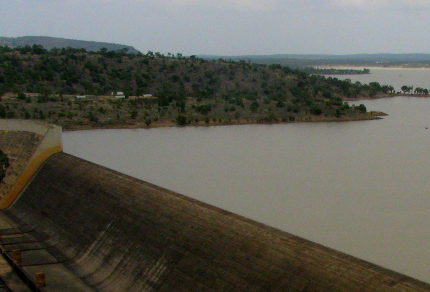I had read and heard that the Burdekin Dam south of Townsville is a good area for birding (particularly for sightings of emus, ground cuckoo-shrikes, and spotted bowerbirds), so I suggested to Vilis yesterday that we check it out. To that end, we rose this morning before first light, packed the Kia with lunch fixings and walking and birding gear, and then headed south out of Townsville on the Flinders Highway.
Past the familiar turn-offs for Mount Stuart and Oak Valley, the landscape was new to us. Open, sparsely-wooded rangeland lay in the shadow of Mount Elliott and its compatriot peaks, with ground mist a silvery-grey haze veiling trees and the grassy groundcover. When not driving, I noted birds and other wildlife in my notebook, listing the black kites and whistling kites that patrolled the ‘Overlander’s Way’, the red-tailed black-cockatoos, red-winged parrot, sulphur-crested cockatoos, and pale-headed rosella that flew over the road or grazed at its edges, and the flock of grey and pink galahs that winged elegant beauty onto a backdrop of dusty, muted vegetation. When I pointed out the galahs, Vilis teased me by saying, “You mean the rose-breasted cockatoos?” in reference to the supposedly more politically correct name for the species.
The ‘Way’ led us into the rolling hills of the Mingela Range and to the Burdekin Falls Dam turn-off at Mingela, a bleak collection of buildings, some of them closed and empty, huddled at the intersection of time and pavement. From Mingela, a well-maintained road of red bitumen carried us southward through cattle station country. Roadcuts and patches of exposed soil in various shades of orange and cinnamon contrasted sharply with the muted olive and silver-green of gum leaves. The bitumen was speckled with cow patties and bordered by surprisingly green verges (perhaps due to recent rains) that had been closely cropped by cattle, some of which grazed unfenced at the edge of the pavement. Most of the bovines ignored the Kia, but a few lunged into motion either toward or away from the road, and a couple of gangly calves loped across right in front of the car. The outback roads we’ve driven in Australia have so far presented us with two driving hazards – loose livestock and road trains. If the wet comes early and we venture inland while the land is caught in its grip, that list will acquire the increasingly significant risk of flooded roads at river and stream crossings.
Forty-odd kilometres from Mingela, we bypassed the turnoff to Ravenswood, and a further 80 kilometres brought us alongside the tall, red-rock embankment of the Burdekin Falls Dam. We pulled off at a boat ramp access to the dammed lake, Lake Dalrymple. A murky, grey-brown amoeba of water, the man-made lake’s sprawling expanse lay caught between ranges of rolling hills cloaked with pale, dusty-looking ground vegetation and widely-scattered eucalypts. A sign at the access road entrance warned that the lake water is inhabited by poisonous blue-green algae which render it unsafe for human consumption or swimming.

Burdekin Falls Dam and Lake Dalrymple (© Vilis Nams)
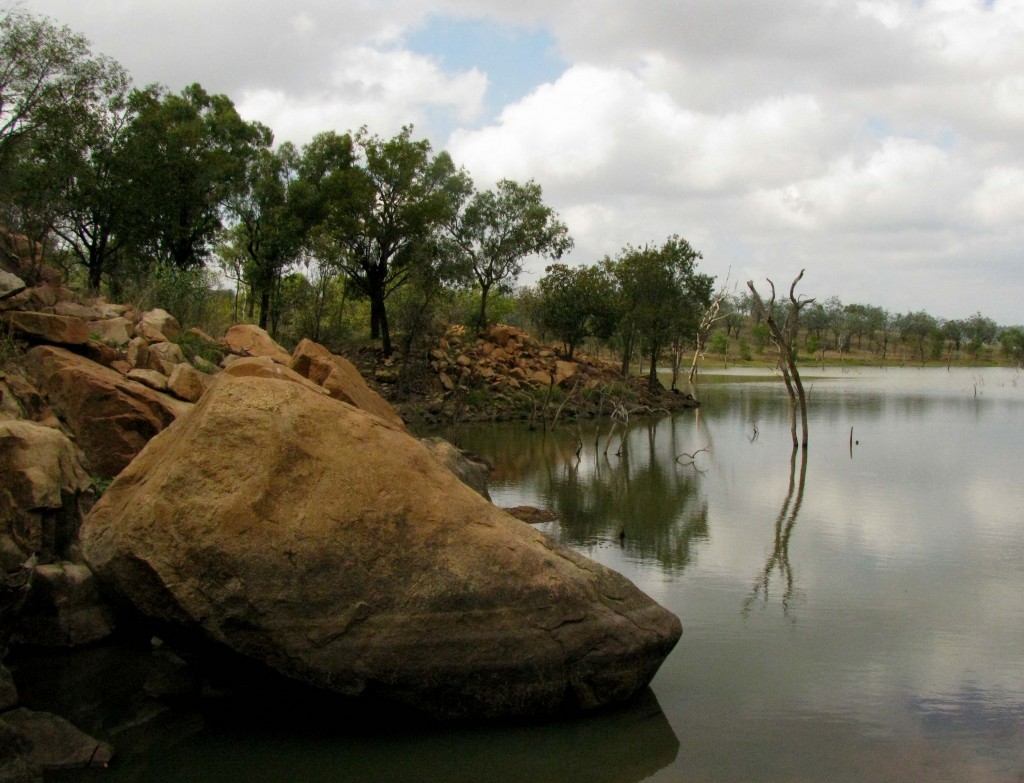
Rocky Shore at Lake Dalrymple (© Magi Nams)
We walked the bleak, rocky lakeshore for an hour and a half, surprised by its diversity of birds and the number of raptors. Pale-headed rosellas clung to the stems of tall herbaceous plants, the black-edged, yellow and blue feathers on their necks and backs resembling a brilliant batik fabric design. Fish-hunters were in evidence – anhinga, little pied cormorant, great crested grebe, great egret, white-faced heron. Apostlebirds and yellow-throated miners fussed in gums, while overhead, whistling kites and white-bellied sea eagles wheeled. A trio of peregrine falcons skimmed over a hillside near granite cliffs and circled in the sky overhead, the birds’ identifying black hoods, white cheek patches, and long, slate-blue wings clearly visible. One of the falcons emitted a series of vocalizations accurately described in my field guide as “hoarse, staccato, complaining ‘chak-chak-chak-chak.”‘1
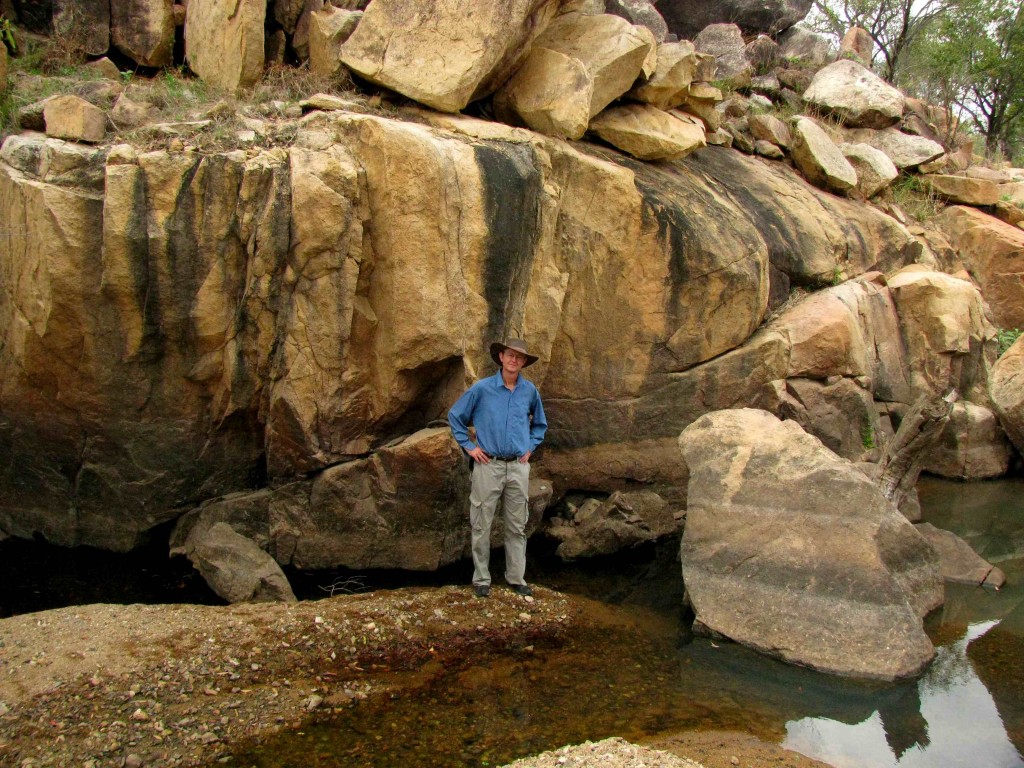
Vilis and Granite Cliffs by Tadpole Pool at Lake Dalrymple (© Magi Nams)
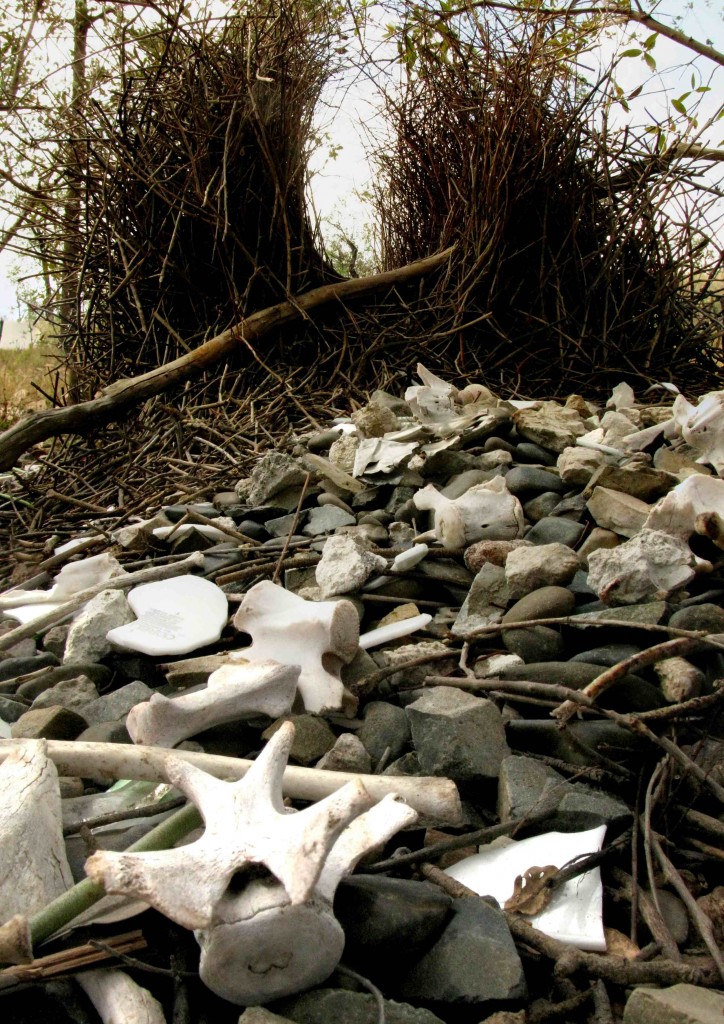
Great Bowerbird Bower at Lake Dalrymple (© Vilis Nams)di
At the edge of a small inlet bound by rocky cliffs, we observed hundreds, perhaps thousands, of tadpoles in shallow water, causing us to speculate at the absence of predatory water birds at that site [We later realized that the tadpoles were likely poisonous cane toad tadpoles.]. We crossed a dry creekbed opening into the inlet and circled above the cliffs, startling macropods into motion. The ground was littered with loose red rock and macropod droppings, making me wonder if the area was as rich in macropod life in the mornings and evenings as the ‘Serengeti of Tasmania,’ a plain in Narawntapu National Park on the north coast of Tasmania, had been during our visit in March (see http://maginams.ca/2010/03/21/).
Farther around the inlet, Vilis spotted an avenue bower decorated with white, red, and green decorations, as are characteristic of the bowers of spotted bowerbirds. However, the bird defending the mating avenue was a great bowerbird, not a spotted bowerbird as I had hoped. The bower was lavishly ornamented with pale stones and bleached bones, these accented by pieces of clear glass in the avenue, and by green twigs and old red fruits outside it. The male bowerbird hissed and rasped at us from within his bower and from perches in nearby trees. On observing the bird perform a ritualized display with ornament in beak, pink crest raised and tail cocked, and head dipping and raising while he hissed and hopped stiffly toward the bower, Vilis commented, “I could sit on a chair and watch him for hours.”

Burdenkin Falls Dam (© Vilis Nams)
Leaving the boat ramp area, we drove to the concrete dam. There, the lake, which was formed by the damming of the Burdekin River in 1987, lay tethered behind a long wall rising high and dry above a barren table of fractured rock smeared with still pools of milky brown water and incised by the small Burdekin Falls caught between granite walls. The photographs I had seen of the dam must have been taken during or just after the wet, for they showed water pouring over that bare concrete wall in a smooth, wide, impressive falls. Now, a single spillway at the base of the falls at one end released water into the river. Nonetheless, the scene, which incorporated the spreading lake (volume four times that of Sydney Harbour2), the exposed river bedrock, and the surrounding dry, mounded hills clad in scattered gums, was a striking one.
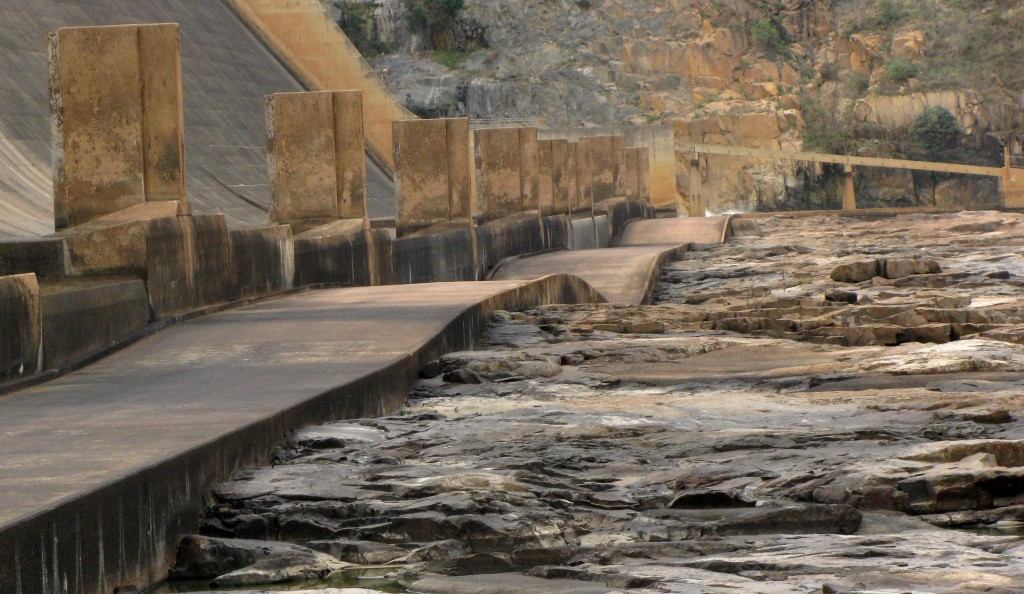
Causeway at Base of Burdekin Falls Dam (© Vilis Nams)
On leaving the lookout, we drove a steep, gated road, which was no doubt closed during the wet, down to the base of the dam and across a concrete causeway that rippled like gentle ribbon candy before ascending a similarly steep slope on the opposite side of the river, and then continuing on toward Collingswood more than 100 kilometres distant. This stretch of causeway was the most intriguing bit of road I’d ever traveled, its bare, undulating surface a delight travelers may savour only during the dry season.
In early afternoon, we turned the Kia homeward, having dipped on all three of the birds I’d been seeking. Still, I was pleased to have again seen two species I’d so far only seen on our excursion to Undara Volcanic National Park in late July, the apostlebird and squatter pigeon. A brief sidetrip into the mining community of Ravenswood provided us with wonderfully close-up views of four Australian bustards. These grassland birds are Australia’s heaviest flying birds and stand around a metre tall, but they didn’t stand still long enough for photographs.

Immature and Adult Emus near Ravenswood, North Queensland (© Vilis Nams)
Vilis snoozed while I drove that solitary, red highway leading north to Overlander’s Way, but jolted into wakefulness when I called urgently, “Vilis! Emus!”
Three emus, one noticeably larger and more pigmented on the neck, walked peacefully from the green verge into the savannah woodland. I turned the Sportage around and slowly paralleled their movement, offering Vilis an opportunity to snap some photos before we exited the vehicle and cautiously walked alongside the tall birds, with about 20 metres of savannah between us and the emus. The larger bird, which we assumed was a parent of the two smaller birds, stayed between us and its offspring, but otherwise appeared unconcerned by our presence. In fact, it seemed quite curious. However, when a fourth emu raced across the road and into the woods nearby, the adult we’d been observing exploded into motion, galloping through the savannah to chase away the intruder before returning to its young. I’d never before seen emus in the wild, and those birds looked so much the iconic Australian species they are, as they stepped with long, strong legs through bleached, dying grasses on the red scalp of this continent.

Male Emu (© Vilis Nams)
Today’s birds: common koel, peaceful doves, rainbow lorikeets, mynas, Australian white ibises, Torresian crows, white-breasted woodswallows, black kites, whistling kites, sulphur-crested cockatoos, pheasant coucals, welcome swallows, magpie-larks, Australian magpies, red-tailed black-cockatoos, red-winged parrot, galahs, pale-headed rosellas, crested pigeons, Australian bustards, noisy friarbird, laughing kookaburras, great crested grebe, white-bellied sea eagles, anhinga, apostlebirds, yellow-throated miners, Caspian tern, little pied cormorant, pied butcherbirds, *peregrine falcons, willie wagtail, great egret, squatter pigeon, Indian peafowl, pied currawong, great bowerbirds, silver gull, fairy martin, wedge-tailed eagle, little friarbird, white-faced heron, *emus, black-faced cuckoo-shrike, little corellas. Also saw an agile wallaby and other macropods. (*denotes lifelist sighting)
Reference:
1. Graham Pizzey and Frank Knight. The Field Guide to the Birds of Australia. 1997. Angus & Robertson, Sydney, p. 140.
2. Wikipedia. Burdekin Dam. Updated 4-Jan-2010. Accessed 6-Sep-2010. http://en.wikipedia.org/wiki/Burdekin_Dam

